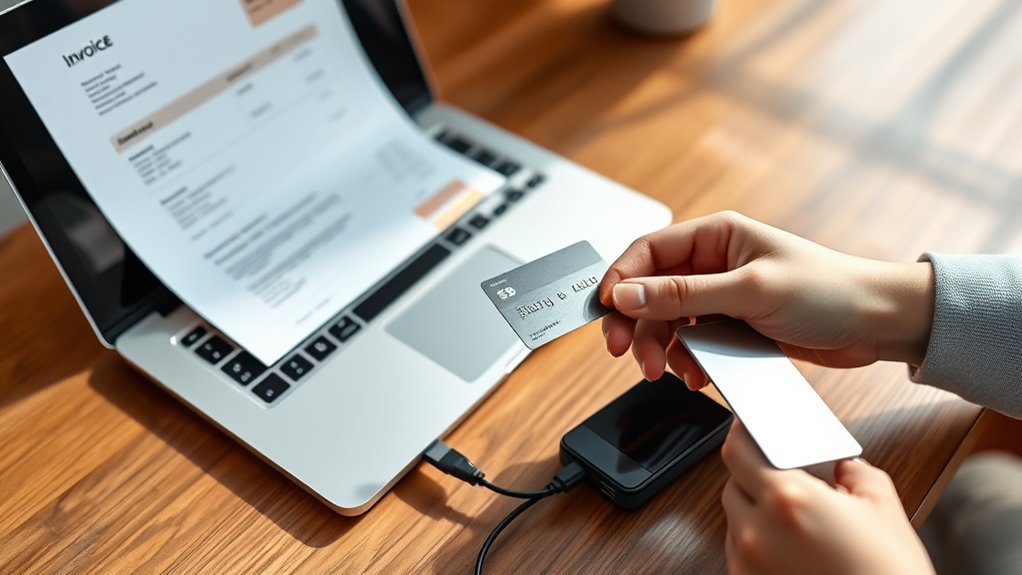To make invoicing hassle-free, you can embed secure credit card payment options directly into your invoices. Use a platform that supports multiple payment gateways, allowing clients to pay instantly with just a click. Enable features like auto reminders and automatic reconciliation to save time and reduce errors. With these tools, you’ll streamline the process and get paid faster. Keep exploring to discover how you can easily set up these features and simplify your payments even further.
Key Takeaways
- Embed secure payment links or buttons directly on invoices for instant credit card transactions.
- Integrate with trusted payment gateways that support credit card processing and multiple currencies.
- Use a cloud-based invoicing platform to easily customize invoices and enable client card payments.
- Automate payment reminders and follow-ups to encourage timely credit card payments.
- Ensure compliance with security standards like PCI DSS to protect sensitive cardholder data.

Are you tired of wasting time on manual invoicing processes? Switching to digital invoicing can revolutionize how you handle payments, especially when it comes to accepting credit card payments. Modern online invoicing platforms make it simple to incorporate multiple payment options directly into your invoices, streamlining the entire process for you and your clients. With support for over 30 payment gateways, you can offer secure credit card payments and electronic transfers, making it faster and more convenient for your clients to settle their bills. This not only improves customer satisfaction but also accelerates your cash flow, helping your business stay financially healthy. Ensuring Regulatory Compliance is essential, as many countries are legislating mandatory e-invoicing and digital payment acceptance to improve transparency and security.
Integrating payment options into your invoices is straightforward. Many invoicing tools allow you to embed payment links or buttons, so clients can pay instantly with just a few clicks. When you send an invoice that includes these options, your clients can pay in their preferred currency and via their preferred payment method, whether that’s a credit card, debit card, or digital wallet. Multi-currency support simplifies international transactions, eliminating the need for complicated currency conversions and reducing delays. Secure online payment processing minimizes fraud risk, giving both you and your clients peace of mind. The entire transaction happens within a protected environment, ensuring sensitive information remains confidential. Additionally, incorporating advanced security measures can further safeguard your payment processing.
Automatic payment reminders and follow-ups are another valuable feature. Once an invoice is sent with integrated payment options, automated alerts can prompt clients to pay if they haven’t already. This reduces late payments and improves your cash flow. Plus, automated data entry and reconciliation eliminate human errors and reduce administrative overhead. When you connect your online invoicing system with your accounting or ERP software, data flows seamlessly, preventing duplicate work and ensuring your records are always accurate.
Accessibility is another key benefit. Cloud-based invoicing platforms let you access your invoices anytime, anywhere, from any device with an internet connection. This means you can send invoices, check payment statuses, and manage client accounts on the go. Instant sharing capabilities speed up communication, so your clients receive their invoices promptly, and you can respond to questions or issues quickly. Customization options, such as branding your invoices with your logo, color schemes, and personalized fields, enhance professionalism and foster trust. If you work with international clients, multi-language support further improves clarity and client experience.
Frequently Asked Questions
What Are the Best Tools for Online Credit Card Invoicing?
You want the best tools for online credit card invoicing. Platforms like Wave offer free invoicing with low transaction fees, making it ideal for small businesses. Stripe supports multi-currency payments and quick checkout, perfect for international clients. Square combines invoicing with in-person sales, plus customizable templates. Keap and QuickBooks automate billing, track payments, and send reminders. Choose a tool based on your business size, transaction volume, and need for automation.
How Secure Are Credit Card Payments on Invoices?
You might wonder how secure credit card payments on invoices are. Modern systems use encryption, tokenization, and biometric authentication, making transactions quite safe. Plus, features like virtual card numbers and real-time fraud monitoring help protect your data. But remember, no system is foolproof. Stay vigilant by setting alerts and using strong security practices, especially since fraud attempts continue to rise. These measures considerably reduce your risk and enhance transaction security.
Are There Additional Fees for Accepting Credit Cards?
You’ll find there are indeed additional fees when accepting credit cards. These include interchange fees paid to banks, assessment fees to card networks, authorization costs, and processor charges. Online or keyed-in transactions tend to cost more, often around 3.3% plus $0.30. High-risk industries or international payments may also face extra charges like chargeback or currency conversion fees, adding to the overall cost of accepting credit cards.
Can I Accept International Credit Card Payments Easily?
Yes, you can accept international credit card payments easily if you partner with a compatible payment processor like Stripe or PayPal. They support multiple currencies, handle currency conversions, and support major global networks like Visa and Mastercard. Just make certain your platform is set up correctly, be aware of potential fees and exchange rates, and verify acceptance rates to make international transactions smooth for your customers.
How Do I Handle Chargebacks on Invoices?
When handling chargebacks on invoices, you should start by maintaining detailed, accurate records that match your invoices and bank statements. Implement chargeback alerts to spot potential disputes early, and educate your customers on the difference between refunds and chargebacks. Use fraud prevention tools and monitor your chargeback ratios regularly. Respond promptly to dispute notices with clear documentation, boosting your chances of winning the case and reducing future risks.
Conclusion
Now that you know how simple it is to accept credit card payments, invoicing becomes less of a chore and more of an opportunity. Imagine turning a tedious task into a seamless experience that boosts your cash flow and impresses clients. It’s like switching from a manual typewriter to a sleek, modern computer—your business evolves. Embrace hassle-free invoicing today, and watch your efficiency and professionalism soar effortlessly.









